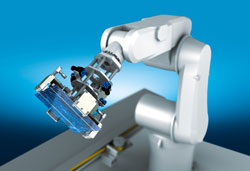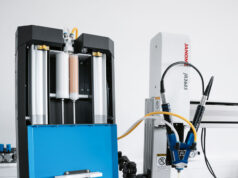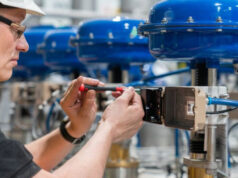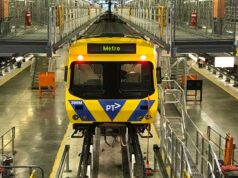
Very thin objects such as solar cells or wafers pose the most stringent requirements when it comes to handling technology. Such substrates are very fragile and, with diameters of up to 300 mm, they have a thickness of merely 0.6 to 0.8 mm. The thickness of thin wafers can even be less than 100 痠. Extremely sensitive objects can nevertheless be securely handled, as SCHUNK demonstrated at Automatica 2008 with a machine from its partner Zimmermann&Schilp Handhabungstechnik GmbH that was especially designed for trade show exhibitions. This involves a robot handling solar cells using a non-contact gripper. It picks up the eight-inch large, 160 痠 thick cells from a depositing unit and places them on the linear transfer unit where they can be further transported without any mechanical contact.
The working principle of the ultrasonic gripper used here is based on so-called “near-field levitation”. This involves an ultrasonic generator being moved close to the workpiece and creating a pressure as a result of the cyclic compression and decompression of a thin film of air between the ultrasonic generator and the workpiece. The pressure protects the workpiece from direct mechanical contact.
To apply this reaction to the construction of grippers, air is simultaneously extracted through holes on the gripper face to create a vacuum. While the vacuum is holding the workpiece, the pressure created by ultrasonic waves in the layer of air prevents the workpiece from coming into contact with the gripper face. Equilibrium is created between the weight of the workpiece, the suction force of the vacuum, and the back pressure of the film of air, in which even the thinnest substrate can be safely held. The workpiece is gripped without friction, and yet securely, without the need for compressed air. The distance between the ultrasonic gripper and workpiece can be between 0.05 and 0.5 mm, and since there is neither friction nor particle contamination, the process is also suitable for use under clean-room conditions.
When the shape of the gripper corresponds to the shape of the component, a fluid-mechanical effect generates a centering force in the case of small components. This force makes it possible to have fast accelerations or to turn the gripper together with the component. When larger parts are to be handled, there are lateral stops that prevent the workpiece from slipping when the gripper moves. Since these stops are only in position to absorb lateral acceleration, there is only minimal mechanical clamping required for the component.
This process, which is generally suitable for all reverberant workpieces made from metal, plastics, or ceramics, can be used for constructing universal grippers and transfer tracks as well as for the non-contact stabilizing of workpieces with unstable forms. Such ultrasonic components are easily integrated into existing machines and can have different sensors added to them. By avoiding mechanical contact between component and workpiece, non-contact gripping reduces losses due to handling damage and leads to an increase in profits.
SCHUNK Inc.
211 Kitty Hawk Drive
Morrisville, NC 27560
Phone: 919.572.2705 or
800.772.4865
Fax: 919.572.2818
www.schunk.com
info@us.schunk.com









